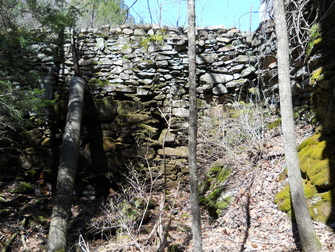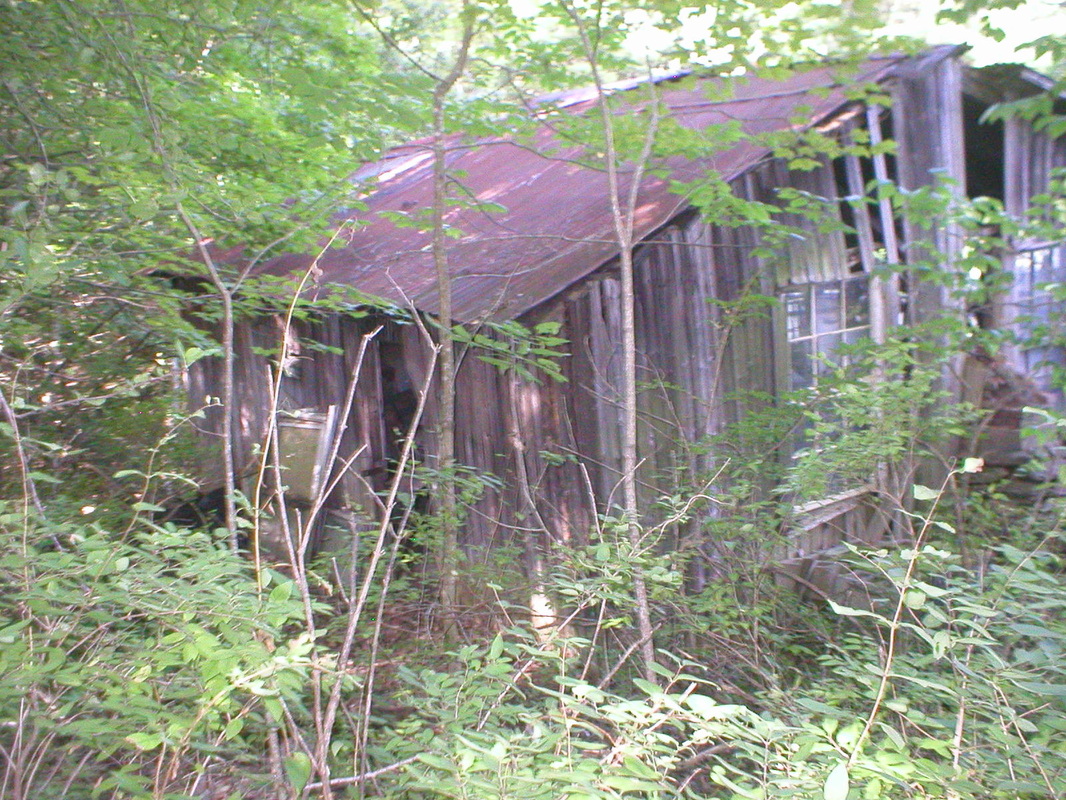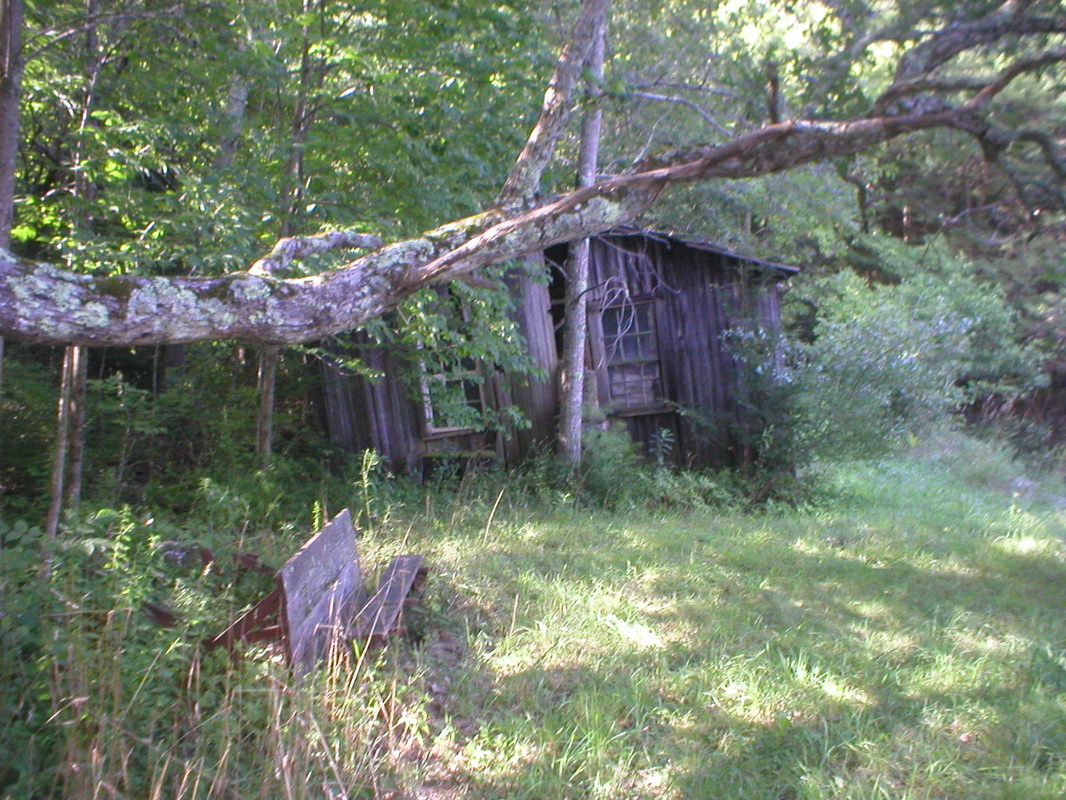sharp's mill, luchon road
 Sharp's Mill dam showing pipe to turbine
Sharp's Mill dam showing pipe to turbine Picture shows three modifications to the dam
Waterway: Conant Brook
Water power: Overshot wheel/turbine
Mill type: Saw, shingle, grist, and button mill
Water power: Overshot wheel/turbine
Mill type: Saw, shingle, grist, and button mill
History: The mill best known as Sharp’s mill for the owner operator, Captain Robert Sharp. This is one of the older documented sites in Willington. Early history is somewhat clouded, but a mill may have been constructed there as early as 1734.
Abel Johnson owned the property in 1790 and was known to operate a saw and grist mill in 1812. The property was purchased by Capt. Sharp, a talented builder, who had a saw and shingle mill in 1815. In 1837 Sharp improved and enlarged the mill by adding a second story, a new grist mill, and building a lower access road to the mill. He increased the power by building a new flume and an overshot wheel of about 14 feet with 42 inch buckets. Rebuilding of the dam required a new emergency spillway to accommodate the additional overflow capacity. To accommodate the additional capacity of the spillway, he had to do considerable blasting to allow for the increase flow of excess water.
Albert Sharp, son of Captain Sharp, later discontinued the saw mill and concentrated his energy and capital on the grist mill until he sold the mill to William Masinda in 1895. In 1903 Masinda established an ocean pearl button shop at the mill site on the lower floor of the two story mill. Masinda continued operating the saw, shingle, and grist mill along with the button shop until it was destroyed by fire in 1907.
The fire resulted in the end of the multi-purpose mill. However, Masinda was quick to replace the mill with a smaller building to accommodate his needs. The building, a smaller one story button mill, approximately 25 X 25 feet, replaced the larger two story mill building. During reconstruction, the mill was converted to the more efficient turbine source of power and continued to operate as the Ocean Pearl Button factory until it closed in 1938. Pearls were shipped from Australia, transferred to rail and then transferred to a horse drawn wagon. Later when trucks were used, they often had to revert to wagons as the trucks could not negotiate Willington’s hills and poor dirt roads. At this writing, additional information has been located. It will be added when verified.
Site Characteristics: Located on Conant Brook, the Sharp’s mill pond is about half way between Parizek Pond to the north and the head of Hall’s pond in South Willington. The mill is located on private property near the intersection of Sharp’s mill, Kollar, and Luchon Roads. An on-stream mill, it was a large two story building, perhaps as large as 40 X 75 feet with a saw, shingle, and grist mil and a button mill.. The replacement button shop remains today but in deteriorated condition. Remnants include the button shop, equipment, button spoil, pond, dam, and turbine.
Additional Sources of Information: Upcoming book on Willington’s Lost Mill Sites
Abel Johnson owned the property in 1790 and was known to operate a saw and grist mill in 1812. The property was purchased by Capt. Sharp, a talented builder, who had a saw and shingle mill in 1815. In 1837 Sharp improved and enlarged the mill by adding a second story, a new grist mill, and building a lower access road to the mill. He increased the power by building a new flume and an overshot wheel of about 14 feet with 42 inch buckets. Rebuilding of the dam required a new emergency spillway to accommodate the additional overflow capacity. To accommodate the additional capacity of the spillway, he had to do considerable blasting to allow for the increase flow of excess water.
Albert Sharp, son of Captain Sharp, later discontinued the saw mill and concentrated his energy and capital on the grist mill until he sold the mill to William Masinda in 1895. In 1903 Masinda established an ocean pearl button shop at the mill site on the lower floor of the two story mill. Masinda continued operating the saw, shingle, and grist mill along with the button shop until it was destroyed by fire in 1907.
The fire resulted in the end of the multi-purpose mill. However, Masinda was quick to replace the mill with a smaller building to accommodate his needs. The building, a smaller one story button mill, approximately 25 X 25 feet, replaced the larger two story mill building. During reconstruction, the mill was converted to the more efficient turbine source of power and continued to operate as the Ocean Pearl Button factory until it closed in 1938. Pearls were shipped from Australia, transferred to rail and then transferred to a horse drawn wagon. Later when trucks were used, they often had to revert to wagons as the trucks could not negotiate Willington’s hills and poor dirt roads. At this writing, additional information has been located. It will be added when verified.
Site Characteristics: Located on Conant Brook, the Sharp’s mill pond is about half way between Parizek Pond to the north and the head of Hall’s pond in South Willington. The mill is located on private property near the intersection of Sharp’s mill, Kollar, and Luchon Roads. An on-stream mill, it was a large two story building, perhaps as large as 40 X 75 feet with a saw, shingle, and grist mil and a button mill.. The replacement button shop remains today but in deteriorated condition. Remnants include the button shop, equipment, button spoil, pond, dam, and turbine.
Additional Sources of Information: Upcoming book on Willington’s Lost Mill Sites


